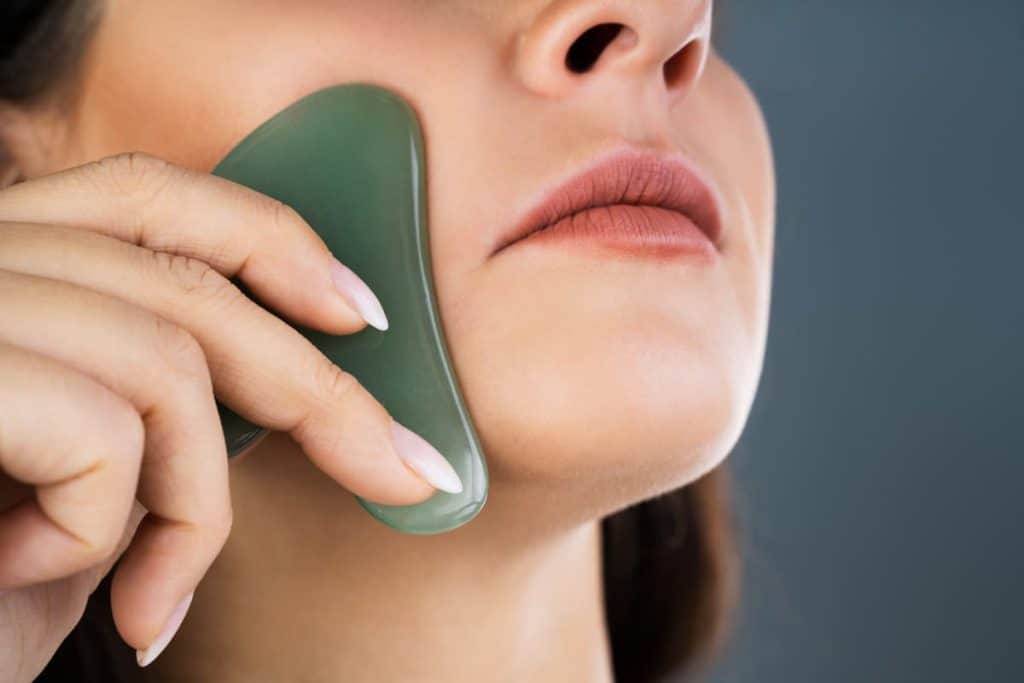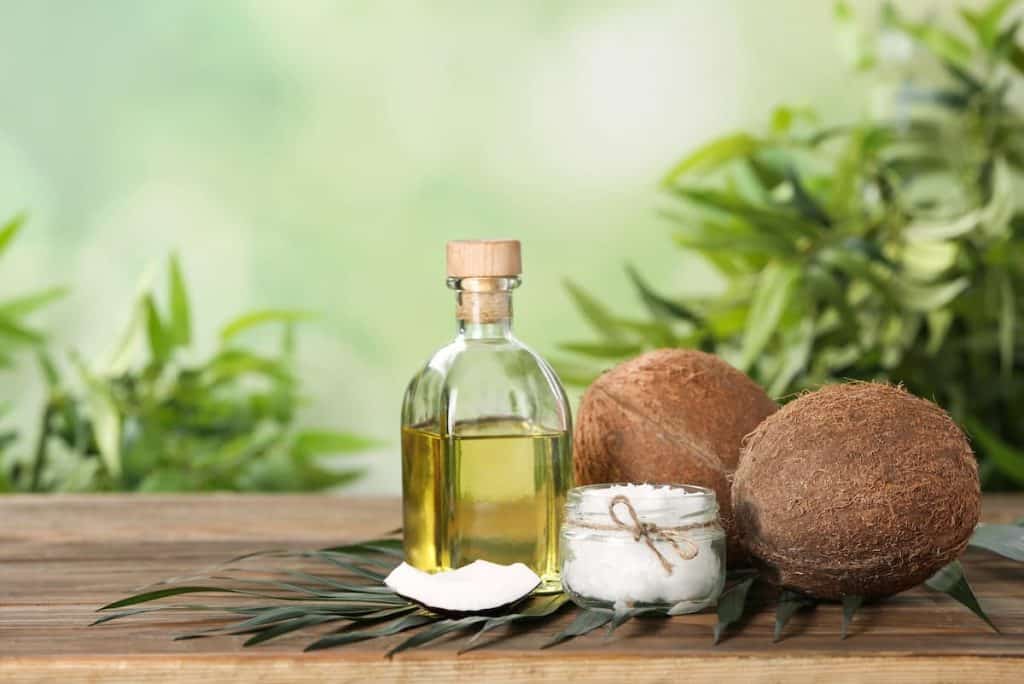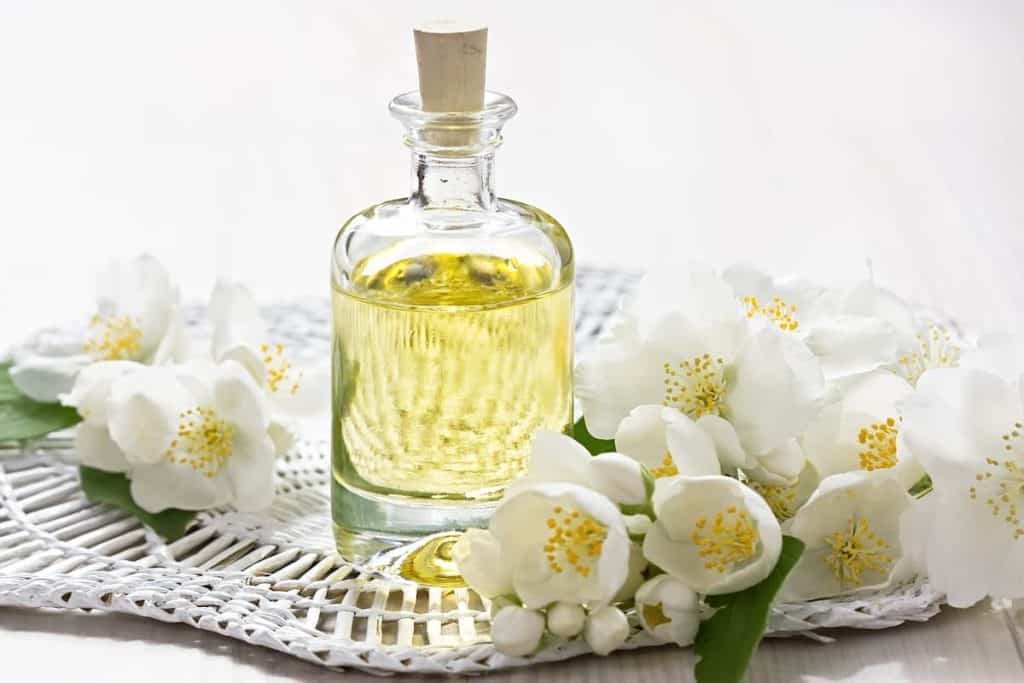16 Top Oils for Gua Sha Based on Your Skin Type
This post may contain affiliate links, which means I may receive a small commission, at no cost to you, if you make a purchase.
Gua sha is currently a skincare trend done by gently scraping skin using a smooth, flat massage tool known as the gua sha.
This traditional Chinese practice is known for its numerous health benefits, including improved lymphatic drainage, relieving muscle tension, and even emphasized facial contours.
One of the key ingredients you need to perform gua sha properly is massage oil.

So what are the top oils for gua sha to use for your skin? Why do you need good oils for gua sha?
Using oil for gua sha can help your chosen stone or wooden tool glide smoothly on your skin, making the process easier, more comfortable, and more effective.
Once you know the right oil that works for you, gua sha can make your skin more nourished, moisturized, and rejuvenated.
Since there are plenty of natural oils to choose from, you might wonder which oil to particularly use for gua sha on the face.
But before you choose which gua sha oil to use, there are some factors to consider.
One of these factors is your skin type. Keep in mind that there is no one-size-fits-all product when it comes to oils. Also, some oils may be a better option for you than others.
You need to find the top face oil to use with gua sha based on your skin type.
Luckily, we can help you with that! This article will present everything you need to know about choosing the top gua sha oils for your skin.
Use this article as your guide to achieving glowing and healthier skin after your gua sha session.
Let’s begin!
Table of Contents
What Is Gua Sha?
Before we talk about the oils you can use for gua sha, let’s first understand what gua sha is and how it works.
Gua sha is a traditional practice in Chinese medicine intended to help improve blood circulation, leading to various health benefits.
A gua sha massaging tool, commonly made out of rose quartz or jade, is typically used today. But traditionally, ceramic spoons, coins, or animal bones were used by Chinese practitioners.
While gua sha can be gently performed on the face for face slimming, this massage is intended for other body parts too. You can use the gua sha on your legs, arms, neck, buttocks, and back.
This special massage can be done by a professional or even at home.
Its goal is not only to give you smoother skin but also to deal with stagnant qi or chi (energy) and relieve its developing inflammation.
The amount of pressure used while doing gua sha depends on your comfort level. But with the help of massage oils, the whole process can go more seamlessly and will be much more tolerable than ever!

Benefits of Using Gua Sha
Here are the amazing benefits that gua sha can offer when done regularly using the right gua sha tool and the right oil:
- Adds facial contours
- Brightens skin
- Combats skin dryness
- Enhances lymphatic drainage
- Facilitates blood flow and stimulates circulation
- Helps reduce pigmentation and acne marks
- Reduces cellulites
- Releases tightness and tension
- Relieves muscle tension
- Erases the dark circles and puffiness under your eyes
- Softens wrinkles and fine lines.
Why Do You Need a Facial Oil for Gua Sha?
Facial oils are used together with gua sha to help boost its efficacy without tugging the skin.
These oils provide ample lubrication so the gua sha tool smoothly glides over your skin.
Using facial oils is crucial when performing gua sha if you want to keep your skin looking its best and if you want to maximize the benefits of this ancient Chinese practice.
As a skincare product, facial oils lock in moisture, preventing irritation and keeping your skin hydrated.
Facial oils also help reduce the appearance of wrinkles and fine lines by plumping up the skin.
Keep reading to find the top oils for gua sha based on your skin type — from dry and oily to sensitive and combination skin types!
Top Oils for Gua Sha on Dry Skin
Dry skin types need a face oil that will help deal with issues such as flaking, dehydration, wrinkles, and fine lines.
To address these, use hydrating natural oils with gua sha to smoothen your skin and restore its youthful and plump appearance.
Some of the top oils to use for gua sha on dry skin include the following:
Coconut Oil

Coconut oil is one of the greatest options you can use with gua sha as it is rich in fatty acids.
If you have dehydrated or dry skin, this natural oil is ideal for you since it helps protect and nourish the skin at the same time.
Aside from that, it can help reduce irritation and swelling thanks to its anti-inflammatory properties.
Take note that coconut oil can clog the pores, which is why it is not recommended for people with oily skin. It is better suited for dry skin, and it’s best used when performing gua sha on the body.
Marula Oil
Marula oil, which comes from the marula fruit tree in South Africa, is another excellent natural oil you can apply on your dry skin for gua sha.
Recently, marula oil has fast become one of the hottest ingredients in beauty products.
It is easily absorbed by the skin because of its lightweight texture. Plus, it leaves a dewy glow on the skin and helps reduce the appearance of wrinkles and fine lines.
Sweet Almond Oil
If you want an intensely moisturizing and nourishing oil for excessively dry skin, sweet almond oil is the right oil to use for gua sha.
Rich in vitamins A and E, sweet almond oil is incredibly hydrating on the skin, which is why this natural oil is widely used for massages.
And thanks to its antioxidant properties, sweet almond oil can also shield your skin from the impurities caused by free radicals. Together with omega-3 fatty acids, it can even reduce the likelihood of getting sunburns.
In fact, traditional Chinese medicine has always used almond oil to treat inflammatory conditions such as eczema, rosacea, and psoriasis.
However, this natural oil can be a bit thick. So try mixing it with jojoba, grapeseed, or rosehip oil to create an ideal face oil for dry skin.
Rosehip Oil
Rosehip oil contains various minerals and vitamins, which makes it a leading ingredient in facial and skincare products.
Research shows that this natural oil can boost the skin’s elasticity levels and collagen and reduce the appearance of fine lines and wrinkles.
If used regularly, rosehip oil can make your skin healthier and younger. It also contains vitamin C, which lightens blemishes and helps fight free radicals.
Experts claim that rosehip is among the top face oils for gua sha, especially on dry skin, since its fatty acids make skin super hydrated. Best of all, it seeps deep into the layers of the skin.
Hemp Seed Oil
This natural oil is rich in omega fatty acids, which moisturize and nourish the skin while strengthening your skin’s moisture barrier.
Thanks to its components, many believe that hemp seed oil is the top skin food for flaky, rough, and dry skin.
Apart from that, it is not pore-clogging and helps retain moisture, making skin look hydrated, lively, glowing, soft, and supple.
Top Oils for Gua Sha on Acne-Prone or Oily Skin
Naturally, oily and acne-prone skin secretes double the oil that other skin types produce. Highly comedogenic or heavy oils will clog pores and add to the overproduction of sebum.
When choosing the perfect oily skin-friendly gua sha oil for the face, look for anti-inflammatory, non-comedogenic, hydrating, and lightweight oils.

Some of the top oils you should apply with gua sha on oily skin include the following:
Tea Tree Oil
Tea tree oil is one of the most popular oils in the beauty industry — for good reason!
Tea tree oil has antifungal, anti-inflammatory, and antibacterial properties, which makes it ideal for clearing up acne and blemishes. It’s best used for oily and acne-prone skin since it controls oil production and soothes irritated skin.
Grape-Seed Oil
This lightweight oil is perfect for those who have oily skin.
Grape-seed oil is rich in vitamins and antioxidants, which help protect, nourish, and moisturize your skin.
It also contains anti-inflammatory properties to minimize irritation and swelling.
Plus, this oil is non-greasy and won’t clog pores — perfect to use with gua sha for your acne-prone skin!
Sesame Oil
Sesame oils are rich in minerals and vitamins, making it ideal for deep skin nourishment. Like other oils, it is great for soothing irritated skin as it contains anti-inflammatory properties.
Though there are limited discussions about the benefits of sesame oil in the beauty industry, it’s actually one of the top oils to use with gua sha since it’s extra calming and nourishing.
Most importantly, sesame oil is non-comedogenic!
Squalene and Squalane
Squalene is used a lot in skincare products because of its promising skin benefits. Usually, this oil is made from the oil in a shark’s liver.
Meanwhile, squalane is squalene’s hydrogenated derivative, a more stable form of squalene that doesn’t spoil quickly when exposed to oxygen.
Due to the ethical concerns of sourcing both squalene and squalane, many brands have now turned to plant-based alternatives such as olives, rice bran, amaranth seed, wheat germ, and sugarcane.
Both squalane and squalene are perfect to use for gua sha since they are hydrating and lightweight. They help reduce fine lines as well as skin inflammation.
Safflower Oil
When it comes to gua sha, safflower oil is becoming a more popular choice among consumers.
This oil is claimed to offer numerous benefits when used together with gua sha. These include reducing pain, promoting tissue healing, and reducing inflammation.
Moreover, safflower oil also helps keep the skin supple by locking in moisture.
Thanks to its linoleic acid content, it is excellent for regulating the skin’s sebum levels, making it perfect for oily skin types.
Top Oils for Gua Sha on Sensitive Skin
If you have skin sensitivities, don’t be discouraged from using gua sha. There are oils for gua sha that are best suited for sensitive skin types!
These oils contain anti-inflammatory properties that calm redness and soothe your skin. They are also very moisturizing and gentle — the perfect combination to help minimize skin irritation.
PRO TIP: When choosing the top oil to use with gua sha on your sensitive skin, beware of any skincare product that may cause irritation. Before introducing a new oil or product, always do patch tests to assess how your skin reacts. Here’s how to do it:
Without further ado, here are the most ideal face oils to use with gua sha on sensitive skin.
Argan Oil
Argan oil is one of the oils loved by people with sensitive skin. Since it’s non-comedogenic, it’s safe to apply on any skin type, especially on sensitive and oily skin.
Aside from that, argan oil has anti-inflammatory and antioxidant properties and amazing soothing properties.
You should get this oil if you want to control sebum production and moisturize your skin at the same time.
Marula Oil
If you have dry, sensitive skin, marula oil is a popular gua sha oil option that you can use.
Marula oil is an easily absorbed, lightweight oil that leaves your skin with a dewy glow after application.
Its comedogenic rating is moderately high, so it feels light yet rich at the same time. Use this oil to keep your dry, sensitive skin nourished and hydrated.
It’s also thought to help reduce irritation and itchiness caused by skin dryness. As a lovely bonus, it can even minimize the appearance of wrinkles and fine lines.
Apricot Kernel Oil
Apricot kernel oil is an effective, lightweight oil that your skin can easily absorb, making it a great oil option with gua sha for those with dry skin.
This oil helps protect and soothe the skin barrier, so it’s also perfect for people who want to calm skin irritation and hydrate their parched skin.
Moreover, apricot kernel oils are rich in anti-inflammatory properties and emollients that can treat skin conditions like psoriasis and eczema.
Jasmine Oil
Jasmine oil is often added to skincare products because it protects and calms sensitive skin. It promotes wound healing, evens skin tone, and treats inflammation.
When applied with gua sha, this oil can effectively boost lymphatic drainage and circulation.
Jasmine oil also minimizes the appearance of wrinkles and fine lines. As a result, you get more youthful, glowing, and brighter-looking skin.

Top Oils for Gua Sha on Combination Skin
If your skin has oily and dry areas, with the cheeks being either normal or dry and the T-zone typically being oily, then you have a combination skin type.
Avoid comedogenic oils at all costs for this skin type to avoid irritating your oily T-zone.
Instead, look for non-comedogenic, hydrating, and lightweight oils that cater to your skin type’s unique needs.
Some of the most suitable oils you can use for gua sha on your combination skin are the following:
Sunflower Oil
Most of the time, sunflower oil is used as an essential oil carrier. This oil is non-greasy, quickly absorbing, and light on the skin.
Sunflower oil can help your gua sha tool smoothly scrape over your skin.
Plus, it retains moisture in your skin, keeping it moisturized and hydrated for longer.
Jojoba Oil
Jojoba oil is recognized for its healing properties and can treat skin problems like psoriasis and eczema.
Because it mimics the natural sebum of the skin, jojoba oil can regulate your oil and sebum production.
It’s also a non-comedogenic oil, which means it will not clog your pores. Thanks to its nourishing components and properties, jojoba oil is an excellent facial oil to use with gua sha for oily and combination skin types.

Conclusion
Similar to choosing the right gua sha tool, you should also choose a facial oil based on your needs, skin type, and skin concerns.
Rest assured that the included oils in this article work well for gua sha massages.
Do note that determining the top oil for you may involve trial and error and that what works for others may not work for you.
Have you already found the oil that’s perfect for you? Let us know in the comments below!
Want to Read More About Traditional Healing?
Check out these articles below:





